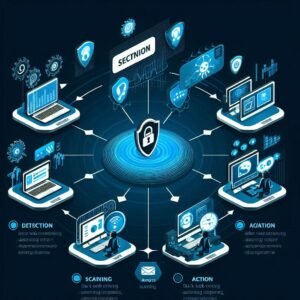Dark Web Monitoring:
Is Your Network Data Being Sold Online?
The internet is vast, with billions of websites, forums, and platforms. But beyond the familiar surface web we use daily lies the dark web a hidden corner of the internet often associated with anonymity, secrecy, and illicit trade. For businesses and individuals alike, one of the scariest realities is that network data, credentials, and sensitive information may be bought and sold there without your knowledge.

This brings us to an increasingly vital question:
Is your network data being sold online and how can dark web monitoring protect you?
In this blog, we will explore:
-
What the dark web is (and how it differs from the deep web).
-
Why cybercriminals trade network data there.
-
The risks of exposed credentials and sensitive data leaks.
-
How dark web monitoring works.
-
Strategies to safeguard your network.
-
Best practices for individuals and organizations.
By the end, you will have a thorough understanding of why dark web monitoring is no longer a luxury but a necessity in today’s digital landscape.
What Exactly Is the Dark Web?
Before diving into monitoring, let’s clear up a common misconception.
The internet is divided into three layers:
-
Surface Web
-
The part we use daily: websites accessible via search engines like Google. (e.g., news sites, e-commerce, blogs).
-
-
Deep Web
-
Legitimate content not indexed by search engines, such as medical records, academic databases, and subscription services.
-
-
Dark Web
-
A small portion of the deep web, accessible only via special tools like Tor (The Onion Router).
-
Known for hidden forums, marketplaces, and often illicit activities such as the trade of stolen credentials, drugs, weapons, and hacking services.
-

Key Insight: The dark web isn’t inherently illegal it’s simply an anonymous space. However, its anonymity makes it attractive for cybercriminals who want to trade stolen data without detection.
Why Is Network Data Sold on the Dark Web?
The dark web has become a bustling underground economy where information is currency. Cybercriminals steal and sell data for profit, exploitation, or identity theft.
Common types of network data traded include:
-
Login Credentials – Email & password combinations from corporate or personal accounts.
-
IP Addresses & Network Blueprints – Useful for launching advanced cyberattacks.
-
Corporate Records – Internal documents, trade secrets, financial reports.
-
Personal Identifiable Information (PII) – Names, SSNs, addresses, and phone numbers.
Stolen data has tangible value.
-
A single corporate network access could sell for hundreds to thousands of dollars.
-
Credit card details may go for just a few dollars, depending on quality.
-
Full identity profiles (a.k.a. “fullz”) are considered gold and command higher prices.

The Risks of Your Data Being Sold Online
Whether you’re an individual user or an organization running global operations, data exposure poses massive risks:
1. Identity Theft & Financial Loss
Criminals can use stolen data to open fake bank accounts, apply for loans, or drain your existing accounts.
2. Credential-Stuffing Attacks
Hackers reuse stolen usernames and passwords to infiltrate other systems. Since many people use the same password across platforms, this method is highly effective.
3. Ransomware and Extortion Attempts
Attackers may sell back stolen data through extortion schemes, costing organizations millions in ransom payouts.
4. Corporate Espionage
Leaked intellectual property gives competitors or hostile actors an unfair advantage.
5. Reputational Damage
Customers lose trust quickly when a data breach is linked to a business, impacting brand credibility for years.

What Is Dark Web Monitoring?

Dark web monitoring is the practice of scanning hidden forums, marketplaces, and data dumps on the dark web to detect whether stolen credentials, personal information, or sensitive corporate data have been leaked.
It acts as an early warning system to prevent misuse by notifying businesses or individuals when their data surfaces online.
Key functions include:
-
Continuous Surveillance – Automated tools crawl thousands of hidden sources daily.
-
Keyword & Pattern Matching – Identifying specific domains, email addresses, or PII.
-
Alerting System – Notifies the affected party immediately if data is found.
-
Actionable Insights – Guidance on steps to reduce impact after a breach.
How Dark Web Monitoring Protects Networks
Let’s break it down:
1. Early Detection of Breaches
Instead of discovering a breach via customer complaint or ransom note, monitoring alerts you much earlier.
2. Reduced Attack Window
The time between breach and exploitation can be critical. Quick identification allows organizations to lock accounts, rotate credentials, and mitigate damage.
3. Regulatory Compliance
Data protection laws (like GDPR, HIPAA) require safeguarding sensitive information. Monitoring helps demonstrate proactive security measures.
4. Proactive Defense
Security teams can prioritize vulnerabilities, strengthen access controls, and prevent escalation.
How Organizations Can Implement Dark Web Monitoring
For businesses, implementing a monitoring strategy involves combining technology with human expertise.

-
Choose a Monitoring Service
Several cybersecurity firms provide dark web monitoring solutions (e.g., Threat intelligence providers, MDR services). -
Monitor Critical Assets
Focus on domains, IP ranges, employee email accounts, and sensitive customer data. -
Integrate with Security Operations
Monitoring should connect with your Security Information and Event Management (SIEM) and Incident Response (IR) teams. -
Employee Awareness
Train staff to recognize phishing emails and implement strong password hygiene. -
Response Playbooks
Have clear protocols for what to do if an exposure is discovered.
Dark Web Monitoring for Individuals
It’s not just businesses at risk. Everyday users should also consider monitoring services, especially with the rise of identity theft.
Here’s how individuals can protect themselves:
-
Use Identity Theft Protection Services (many include dark web scanning of your emails, SSNs, or phone numbers).
-
Enable Multi-Factor Authentication (MFA) to block attackers even if your password leaks.
-
Use Strong and Unique Passwords with a password manager.
-
Regularly Check Breach Databases such as “Have I Been Pwned.”
-
Monitor Financial Accounts for unauthorized activity.

The Future of Dark Web Monitoring
With the evolution of cybercrime, monitoring tools are becoming smarter:
-
AI & Machine Learning – Advanced anomaly detection to spot suspicious patterns faster.
-
Automated Threat Response – Integration where detection triggers instant security actions.
-
Cross-Industry Collaboration – Governments and private sector organizations working together to dismantle cybercrime marketplaces.
-
Preventive Intelligence – Not just reacting to breaches but predicting emerging threats.
In the near future, dark web monitoring will likely become a default layer of cybersecurity for both organizations and everyday internet users.

Final Thoughts
The dark web isn’t going away and neither is the cybercriminal economy that thrives there. What businesses and individuals can control is how swiftly they detect, respond to, and contain data exposures.
Dark web monitoring doesn’t stop breaches from happening, but it significantly reduces the time to detection and limits the damage caused by stolen data.
If you’re wondering, Is my network data being sold online? the answer might very well be yes, or it could be tomorrow. That’s why integrating dark web monitoring into your security posture is no longer optional.
Whether you’re a global enterprise, a small business owner, or simply an individual with digital accounts, the real question isn’t whether hackers will target you it’s whether you’ll be ready when they do.